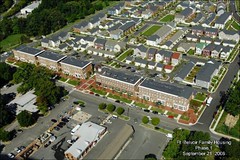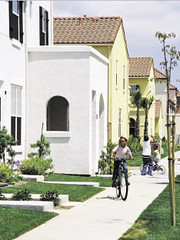Can smart growth and urbanist design enhance military life?

Posted May 25, 2009 at 5:41PM
On a day when we remember America's military and their families, let's also acknowledge and honor the efforts that our Army, Navy, and other uniformed services are undertaking to enhance sustainability and livability. Not only can this raise the standard of living for our soldiers, sailors and their families, but it can also set an important example for civilian applications. There is also the impact of sheer numbers: the US military controls 30 million acres of American land.
Last year I wrote about how base housing at Fort Belvoir, south of Washington, DC, was being transformed into 15 walkable villages, along with a mixed-use town center. That project (photo below) won a Charter award from the Congress for the New Urbanism, along with commendations from the National Association of Home Builders and American Planning Association.  Especially given that base realignment and consolidation is bringing tremendous growth to Fort Belvoir, the model is instructive.
Especially given that base realignment and consolidation is bringing tremendous growth to Fort Belvoir, the model is instructive.
Across the country, the Village at the Naval Training Center in San Diego (photos at top and below) won a national award for smart growth achievement from EPA in 2003 for creating a 50-acre redevelopment parcel with 500 affordable housing units, a seven-acre site for a future elementary school, a community center, recreational space, and walking-distance shopping in the Navy Exchange. From EPA's citation:
"With well-designed public spaces, pedestrian-friendly streetscapes, and regional architectural styles, the Village integrates smoothly with the existing residential and commercial context of the historic city. Implementation of smart growth principles can be seen throughout the Village. Not only is it located within three miles of downtown [San Diego] on an underutilized urban site,
but it is connected seamlessly into the existing urban fabric, and provides access to alternative transportation options and a public school site."
A comprehensive sustainability effort at Fort Lewis in Washington state is also gaining some recognition. Writing in USA Today, Haya El Nasser reports that the installation is incorporating smart growth principles in part to reduce the amount of land needed for housing:
"Fort Lewis, a post south of Tacoma, Wash., is touted as a model of the new [smart growth] philosophy. The active-duty population was 18,000 five years ago. It's now 30,000 and is expected to top 32,000 by 2012, says Col. Cynthia Murphy, garrison commander . . .
"The military doesn't want to touch land used for training, which it views as vital. That means overhauling the base's old development plan. About 600 people met in workshops - 'from junior soldiers to the most senior leadership to families of deployed soldiers ... single soldiers, retirees,' Murphy says.
"A planning vision emerged: A main boulevard with sidewalks, side streets for slower traffic, 2- to 3-story buildings for denser development, retail stores on the street level, a distinct downtown. It identified 12 neighborhoods that would have their own mini-downtowns. All would be connected to the main town center."
El Nasser notes that the new trend, which is also being picked up in Camp Pendleton (CA) and Fort Bragg (NC) [note: not to mention Guam], represents a significant turnaround for bases that have long followed an automobile-dependent sprawl model of shopping, housing, and other community functions widely separated from each other.

